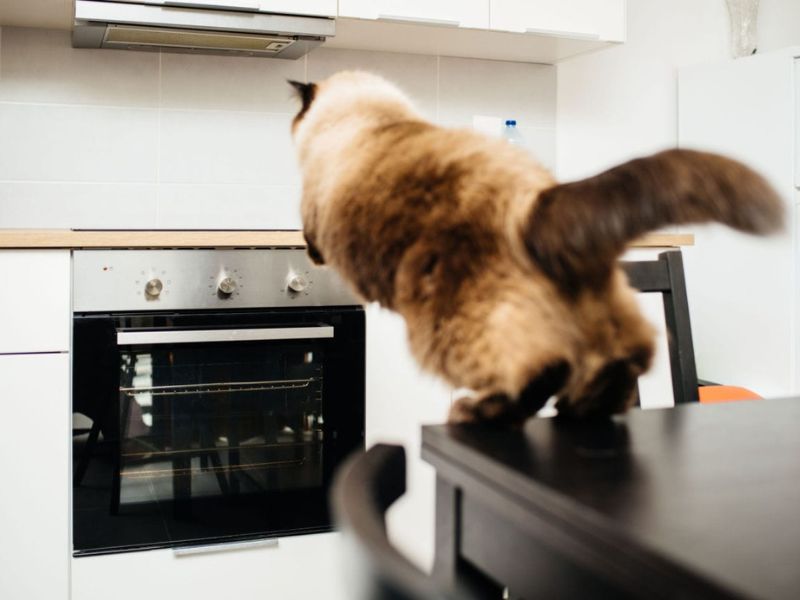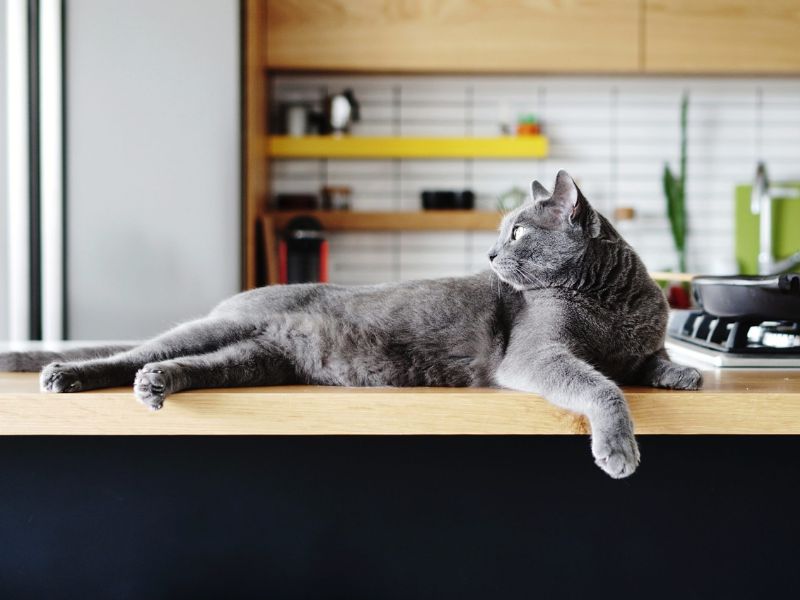Those who have cats as pets know how adventurous and curious they can be. They may end up investigating inappropriate areas, such as kitchen counters, as an undesirable result. It’s annoying when your cat likes to jump on the counter, but there are ways to teach them how to behave better. This post from Canvas Personalized will show you how to train a cat to stay off counters and other discouraged positions.
Why Do Cats Jump on the Counter?
There are several reasons why kitchen countertops are cat attractions. You may change your cat’s behavior or distract it once you know why it enjoys the countertop so much.

- Cats love heights
Put any two cats in the same room with a cat tree or cat tower, and you have the makings of a game of “King of the Hill.” Most cats can easily reach countertops by jumping up from the floor or using strategically placed furniture.
- The kitchen counters smell good
Tempting foods like raw chicken, ground beef, or last night’s leftover tuna casserole are commonly stored in them. Moreover, cats love to eat the crumbs and spills that might gather on a countertop that isn’t cleaned properly.
- Cats like fresh running water

Some cats are also attracted to running water in the kitchen sink, and for many cats, this is their main source of drinking water.
Why Your Kitty Shouldn’t be on Counters?
It may seem easier and safer to let your cat enjoy themselves on the kitchen counter, but there are a few reasons why you should not do so.

- You probably don’t want fur or other animal products in your meals.
- Toxic or sharp items, knives, or a hot stovetop might all be resting on your counter and could easily cause harm to your cats.
>>> Read more: How to Train a Cat to Use a Litter Box in 3 Effective Steps?
How to Train a Cat to Stay Off Counters?
Eliminate Temptation when Training cats to stay off counters

Address the trigger that is obvious first: food! A hungry cat will unavoidably find its way to the kitchen. It’s crucial that you maintain a clean sink and countertops. Besides, dishes should be washed as soon as possible, and food should be included on countertops, particularly in plastic bags.
Moreover, leaving cat food in plastic containers is risky because cats may try opening them to get to the surprises. They could accidentally eat something poisonous, such as a plastic bag or its contents. Or if their face gets stuck within the sack, they might suffocate.
Make the Counter Unappealing for Your Cat To Walk On

It’s not your goal to make your cat uncomfortable; you want it to learn to avoid the counter. Try using a sheet of double-sided pet tape on a piece of plastic or crumpled aluminum foil on the kitchen surface. Instead of simply applying the tape, you may place this down wherever it is most convenient on the counter.
Give Your Cat What They Need

The reason your cat started jumping on the counter the first time is something you should consider. They are likely trying to fill an empty space, and you may be able to offer them an appropriate alternative.
If your cat often uses the kitchen counters as a hiding spot from the dog or as a place to watch the activity during meal preparation, setting up a cat tree or cat shelf, there could be the best solution.

Perhaps your cat is hungry because you feed it not frequently, and it is climbing up on the countertops to find something to eat. Or your cat might be bored. To meet their requirements in these situations, you may want to check out the times they are fed and allowed to play.
Stop Your Cat From Jumping on the Counter
Pick up your cat as gently as possible if it jumps up on the counter and bring it back on the floor. Avoid making any eye contact or conversation with them. Even a firm “no” might seem like a reward if your cat engages in attention-seeking behavior like leaping up on the counter.
Redirect Them to the Appropriate Alternative

When you take your cat off the counter in a relaxed way, you should wait about 60 seconds. Then lure them with treats or toys to a safer high perch where they may get the exercise they need. You want them to understand that climbing up on the counter will result in a quick fall to the floor. On the other hand, when they make the right choice, they are rewarded with sweets and clear praise. Over time, they’ll stick toward the more profitable alternative.
Look for Opportunities To Provide Positive Reinforcement
It is more likely that a rewarded act will be repeated. Make it delicate to praise them if they independently decide to sit in an appropriate alternative position.
Tips for Training a Cat to Stay off Counters

In general, while teaching your cat how to do anything, you should focus on making the expected behavior more appealing and the unexpected behavior less so. Keeping your cat away from the countertops will not be successful if you don’t provide her with an appealing alternative.
You should first consider how to suit your cat’s want to be up high, see the world below, and hang out with you (where she can see what you’re doing) while you cook. Because you spend most of your time on the ground, you may neglect the many possibilities in your house’s “high-up” areas.
>>> Further reading: Top 10 Helpful & Crucial Kitten Training Tips For Beginners
To fulfill your cat’s need for altitude, consider the following suggestions:
Clear off windowsills so she can sit on them

Leave some space on the windowsills so your cat may rest there. If you don’t have a window seat, you could choose to make room on an end table or sturdy stool near a window.
Attach a cat bed or play mat to the back of chairs in your home, preferably those positioned near windows.
Your cat could get the message that it’s okay to hang out in such locations if you do this, and at the same time, you’ll save your furniture from getting hair all over it.
Consider a cat tree or two

Cats have a strong preference for large, safe cat trees that have levels at window height and have broad, solid bases. They provide several benefits for your cat: scratching, perching, and sleeping.
Provide enough spots for all of your cats
The number of cats you have will determine the number of perches you provide for them. The conflict that results from some cats not having access to them might lead to undesirable behavior, so it’s best if they all have access to them.
Providing your cat with a place to perch high up and look out the window is sure to make her happy. Try to make your new cat places that are more appealing if she keeps ignoring them. Catnip or honeysuckle spray may be used to attract them. Set a bird feeder in front of a window or put your cat’s favorite toys on them.

You should also provide your kitty a place to hang out while cooking to train a cat to stay off counters. Setting up a cat tree so your cat can see what you’re doing on the counters might be quite useful if you have the space for it.
You may also teach her that a sturdy stool or chair is hers by inviting her up on it and rewarding her with goodies, affection, and praise whenever she uses it. If you involve her in the kitchen conversation, you’ll both enjoy the time together more.
Another “how to train a cat to stay off counters” tip is to play with your cat before preparing her food and reward her with a few treats or her regular meal. She could be happy to eat or sleep while you get things done.
>>> Read more:
- How to Leash Train a Cat in 5 Brilliant Steps?
- How to Train a Cat to Come? – 7 Painless Step-by-step Guide
Training a cat to stay off counters may take some time and care, but the work is well worth it. If you use reinforcement and make other things easily accessible to your cat, you may train it to avoid the counters. Always aim for consistency in your workouts; don’t give up if you don’t notice improvement immediately.
Doing so may assist your feline buddy in gathering healthy habits while keeping your counters clean and clutter-free. You and your cat may live in a pleasant home with little effort and creativity.










